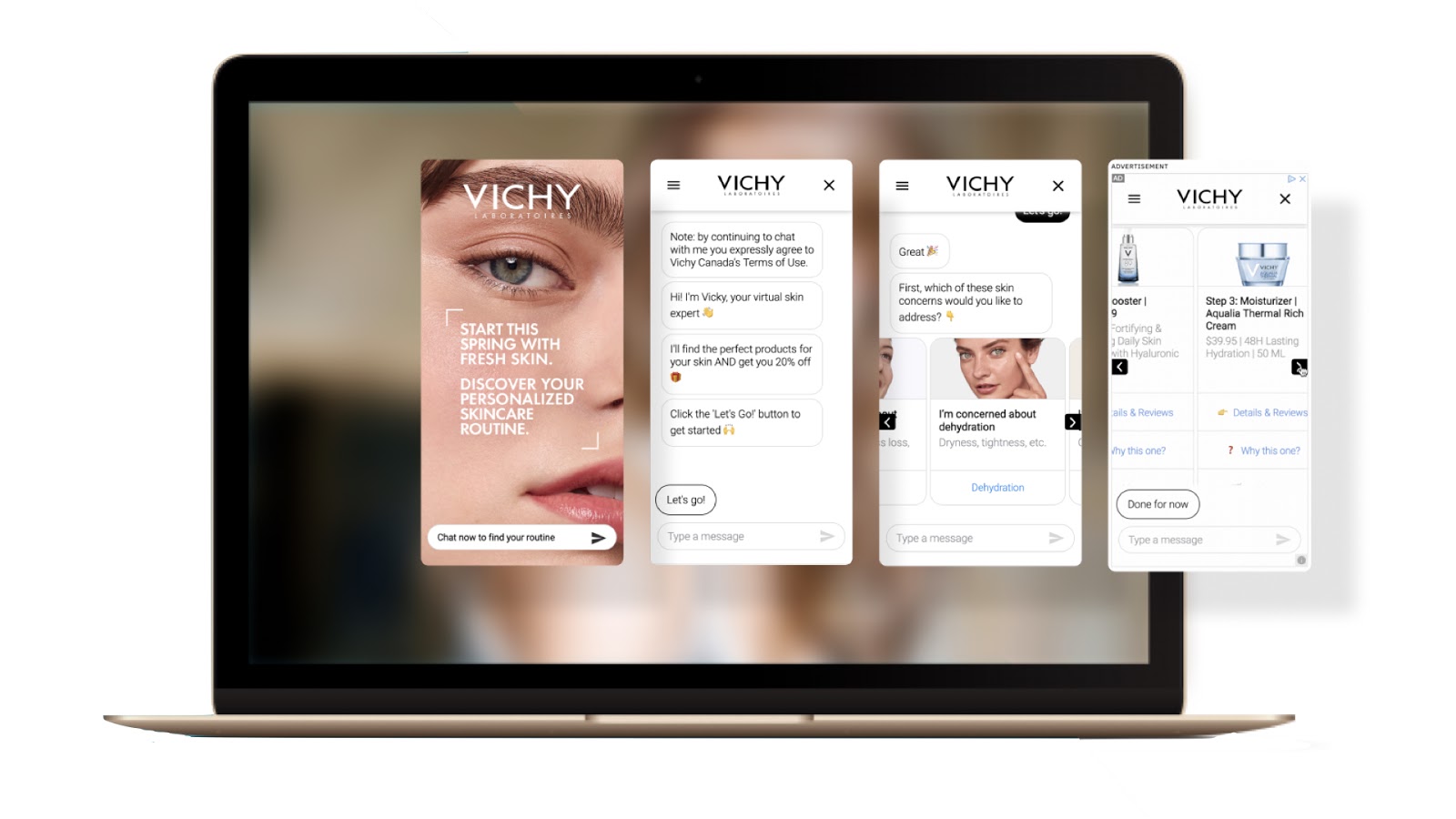Advertising is experiencing a fundamental shift. Social media stories and influencers now drive growth for both brands and platforms. Digital now accounts entirely for Out Of Home advertising growth. Brands are increasingly emphasizing human sales and customer service. Experiential marketing budgets are shooting up. Every brand is looking for new, more targeted or more intimate opportunities to connect with consumers and help guide them to purchases.
All these cases are creative, agency or production-intensive, and rely on broad-based messaging or high degrees of human effort. There are an increasing variety of examples complementing this, where automated personalization is improving the results of campaigns and driving more consumer choices.
Ultimately, for all their effort to get closer and more targeted, brands still don’t get to reach consumers on a true one-to-one basis. This is because, in all these efforts, the messages only go one way - that is, towards the consumer. The consumer rarely gets an opportunity to talk back (unless they’re dealing with a person), and the brands don’t have an opportunity to then continue the conversation in a predictable, cost-effective and scalable way.
Conversational AI is emerging to challenge this framework, however. By allowing brands to automate conversations with consumers at any point in their customer experience, brands are creating ultra-personalized, two-way engagements that lead to truly one-to-one experiences. Leveraging solutions like chatbots and voice assistants, brands can let AI do the talking, and benefit with greater engagement, insight, sales and satisfaction. This trend is only just started, yet Juniper research predicts that by 2023, chatbots alone could drive over $112 billion in annual retail sales.
Why a Brand “Talking” Is Nothing New
Typically, brands talk to consumers in two ways—either through campaigns, directed at an audience, or through representatives in sales and support that interact with consumers on the brand’s behalf. We hear a lot about brand integrity, consistency, and the importance of customer experience practice in winning and retaining more business. What software providers don’t talk about is the degree to which human involvement is still needed in most of these interactions, and how the limits of legacy technology may be leaving brands behind.
There are a variety of challenges with both of the classic ways in which brands talk to consumers. For instance, most consumers are inundated with brand messages (as many as 10,000 per day). Most consumers distrust advertising, associate them with fake news, or are otherwise “cord-cutting” away from major marketing channels and choosing to pay for ad-free experiences.
As for brand representatives, most consumers don’t necessarily trust that their opinions are objective, and will often avoid them and their own research on their mobile devices, even while in brick-and-mortar stores. Brand representatives can also be worn out by repetitive tasks, offer sometimes inconsistent messaging, and otherwise be too expensive to deploy in most cases where consumers need help.
In both these cases, changing the conversation and providing messaging solutions that are instant, immediate and personalized can yield positive benefits by engaging consumers a different way. Instead of relying exclusively on channels and experiences that may be tiring your audiences out, giving them something that they can actually talk to lets you then tailor the messages to their wants and needs. This provides more value to the consumer, but it also allows you to learn more about them, and gives you an opportunity to generate deeper investment in what your brand offers.
How Conversational AI Works
Conversational AI is basically any machine that a person can talk to (learn about it in-depth here). In the past, this was usually isolated to technologies like Interactive Voice Response systems, which fielded and routed customer support calls through a conversational support interface. Later iterations of that technology through channels like email and live chat were still focused on customer support, but recent advances in AI technology now make a host of new interactions possible across marketing channels, in ecommerce and also through new support scenarios.
These interactions are done primarily through chatbots, which can be deployed on a brand’s website, through social messaging apps like Facebook Messenger, and through voice assistants, mobile assistants, smart speakers and more. All these many channels add up to opportunities for AI to communicate directly with consumers, and when framed properly, take on relationships with them that provide the assistance and support they need to find the right products and get the most value of them. This is even possible through solutions like conversational advertising, where formats like display ads are being shaken up by including chatbots that consumers can use to start evaluating products—all directly from an ad!
 Most marketers believe that AI is best applied to backend functions where large amounts of data, obtuse analytical challenges, or other predictive tasks can be automated to increase the overall efficiency of our traditional marketing solutions. In reality, those solutions aren’t the real strength of AI, because they don’t have the capability to yield compounding value as brands use them. Brands need AI that can actually generate data and automate the interactions that consumers are looking for. This approach can yield better results by creating a more seamless customer experience from a first path-to-purchase, all the way to replenishment and support scenarios. Added benefits also come when brands “remember” consumer preferences as expressed in conversational experiences, storing them in systems of record like CRM and leveraging them in later campaigns.
Most marketers believe that AI is best applied to backend functions where large amounts of data, obtuse analytical challenges, or other predictive tasks can be automated to increase the overall efficiency of our traditional marketing solutions. In reality, those solutions aren’t the real strength of AI, because they don’t have the capability to yield compounding value as brands use them. Brands need AI that can actually generate data and automate the interactions that consumers are looking for. This approach can yield better results by creating a more seamless customer experience from a first path-to-purchase, all the way to replenishment and support scenarios. Added benefits also come when brands “remember” consumer preferences as expressed in conversational experiences, storing them in systems of record like CRM and leveraging them in later campaigns.
This is exactly what conversational AI is built for, because it can provide consumers instant, personalized responses to their most immediate questions, while also offering the guidance and recommendations necessary to make their product choices as easy as possible. For large brands with multiple lines of business, this is where conversational AI can have the most impact—the more complex the decision, the more a consumer needs quick, easy and informative answers they can rely on.
.jpg?width=512&name=unnamed%20(8).jpg)
How Brands Can Use Conversational AI
As a brand or marketer, deciding where to start with conversational AI comes down to understanding the use case you want to serve. These use cases depend partly upon your industry, partly upon your short and long term goals, and partly upon the ways in which you think you can improve your relationships with customers. A couple examples are as follows:
Beauty Brands: Consumers face a lot of complexity when choosing beauty products, and given the nature of the products, they also expect interactive, personalized experiences that speak to their own needs, wants, and sense of self.
With conversational AI, you can create a diagnostic or quiz that reveals a consumer’s biggest concerns, preferences, or interests. Whether it’s for something like makeup or skincare, you can use that information to provide them recommendations around routines, product regimens, and other product choices. This ultimately has an immediate impact in increasing sales, and gets more out of an ecommerce investment.
Banks: The variety of digital services available today have increased consumer expectations for instant and seamless experiences. Having become accustomed to various fintech solutions, consumers also want relevant and instant responses to even their most delicate financial concerns.
Providing a virtual assistant (which many banks have already done) can allow consumers to book and prepare for appointments, perform basic account management functions and even give them quick access to support representatives who can manage any issues or tasks for them. This can also be used for lead-generating activities, where chatbots consistently outperform the types of detailed forms that are required in financial services.
.jpg?width=512&name=unnamed%20(9).jpg)
Automotive Companies: Consumers spend a long time considering the best vehicle to purchase, and usually want to narrow down the options available to them know all the options available before visiting a dealership, getting a test drive or making a final decision. If they don’t know a lot about cars, they’ll also need recommendations, since going through all the information available can be overwhelming. Conversational AI can offer consumers relevant questions, generate data about them that makes other messaging easier to personalize, deliver rich, relevant content through messaging channels and ultimately convince consumers to convert, whether through booking test drives, visiting a dealer or other milestones in the path to purchase.
All of these scenarios offer tremendous variability and flexibility, but come down to the core concept of providing consumers the answers they need while offering guidance and recommendations that direct them to their best choices. When consumers and brands find the most possible value in each interaction, everybody wins!
.jpg?width=512&name=unnamed%20(10).jpg)
Letting Conversational AI Do the Talking
It may seem like a great leap forward to hand off customer interactions to a machine intelligence, but, in reality, it's one of the best, most reliable choices that you can make.
Conversational AI still requires proper scoping, design, and expertise to ensure that the experience delivered gives people the most possible value. It can only provide a human touch if it’s built with the sensitivity that marketers and designers have to human interactions, as well as the industry and product knowledge required to be a true expert on its own. Once deployed, the solution can take on a life of its own in driving deeper engagement with consumers, all in the ways that matter to them.
The benefits speak for themselves: multiple minutes of engagement per interaction, along with multiple data points per interaction and 30% sales lift compared to traditional web experiences. The opportunity for brands lies not only in meeting and exceeding basic consumer expectations, but offering connected experiences across more channels than ever before. From ads and search portals to websites, social media, voice assistants and even in-store through utilities like QR codes, you can let consumers pick up conversations right where they left off, seamlessly, and ultimately create deeper relationships than you may have previously thought possible.
Automat provides conversational AI for brands. Contact us to learn more about what use case might fit best with your business.
Robert Ravensbergen
Virtual advisors and conversational AI have the ability to transform every aspect of the customer experience. I build awareness on how marketers and technology leaders can transform their marketing, commerce and support approaches with these emerging technologies.



